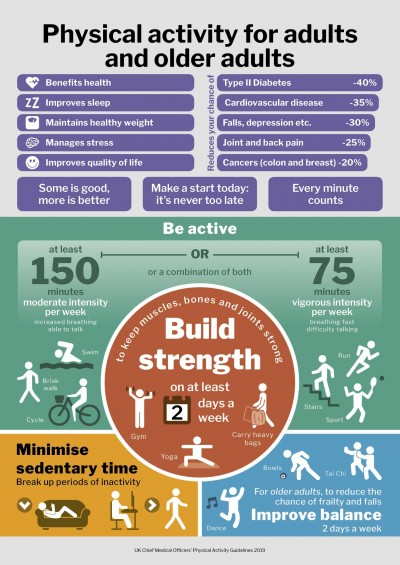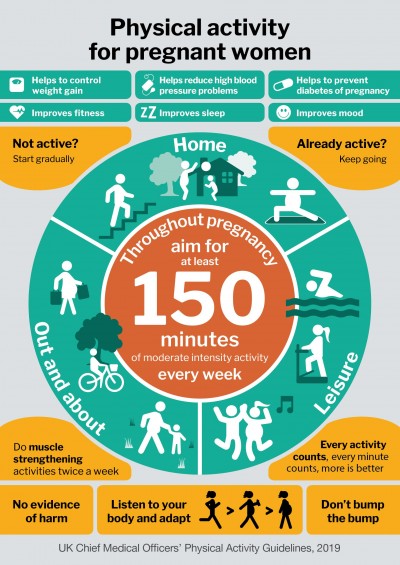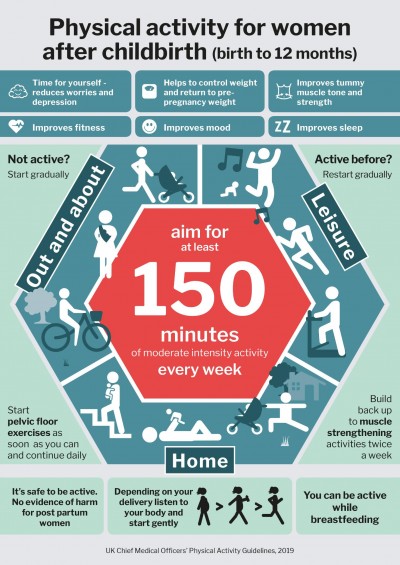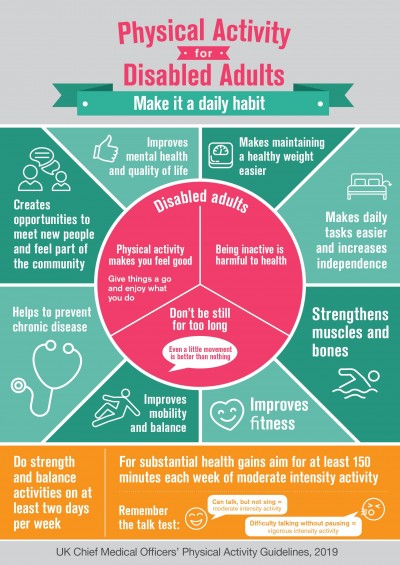Chapter 1 - The UK Physical Activity Guidelines
This section has been developed as a summary of the new 2019 UK Chief Medical Officers (CM0) physical activity guidelines document, 1 for all health professionals. It is the first section of this website to enable all health professionals to increase their knowledge of physical activity.
Physical activity guidelines for Under-5s
The evidence-base on physical activity in the Under-5s has expanded substantially since the development of the previous set of guidelines.2 There is now a large body of evidence that show the amount of physical activity in the Under-5 period influences a wide range of both short-term and long-term health and developmental outcomes. 3,4 For example, low levels of physical activity have been recognised as a contributor to increasing rates of child obesity in this age group. 5, 6 It has become very clear that higher levels of physical activity are better for health, and lower levels worse, and that there are benefits to increasing levels of physical activity across the distribution of starting physical activity level. 3, 4
Despite concern over levels of physical activity in the Under-5s, in both boys and girls, the average level of physical activity reaches a lifetime peak around the age of school-entry (5 years old) and declines thereafter (17-19 years old). Maximising the higher levels of physical activity in the early years should therefore help maintain higher levels later in childhood and adolescence. 3,4,7,8

Infants (less than 1 year):
- Infants should be physically active several times every day, in a variety of ways, including interactive floor-based activity e.g. crawling.
- For infants not yet mobile, this includes at least 30 minutes of tummy time spread throughout the day while awake (and other movements such as reaching and grasping, pushing and pulling themselves independently, or rolling over); more is better.
NB: Tummy time may be unfamiliar to babies at first, but can be increased gradually, starting from a minute or two at a time as the baby becomes used to it. Babies should not sleep on their tummies
Toddlers (1-2 years).
- Toddlers should spend at least 180 minutes (3 hours) per day in a variety of physical activities at any intensity, including active and outdoor play, spread throughout the day; more is better.
Pre-schoolers (3-4 years):
- Pre-schoolers should spend at least 180 minutes (3 hours) in a variety of physical activities spread throughout the day, including active and outdoor play. More is better; the 180 minutes should include at least 60 minutes of moderate-vigorous intensity physical activity (MVPA).
Physical activity, in the Under 5s should not be viewed in isolation, but more as a continuum into older childhood and adolescence. There is increasing evidence for the benefits of adequate physical activity and sleep and the risks of some sedentary behaviour in school-age children and adolescents. 9-11 Levels of these behaviours in the pre-school period are closely related to later levels in school-age children and sedentary behaviour increases from the age of school entry which then displaces physical activity and/or sleep. 12-15
Download the new CMO infographic here
Children and young people (5-18 years of age):

- Should engage in moderate-to-vigorous intensity physical activity for an average of 60 minutes per day across the week. (This activity can include all forms of activity such as physical education, active travel, after-school activities, play and sports).
- Should engage in a variety of types and intensities of physical activity across the week to develop movement skills, muscular fitness, and bone strength.
- Should aim to minimize the amount of time spent being sedentary and when physically possible should break up long periods of not moving with at least light physical activity
Download Children and young people infographic here
Adults (aged 19-65):

- For good physical and mental health, adults should aim to be physically active every day. Any activity is better than none, and more is better still.
- Adults should do activities to develop or maintain strength in the major muscle groups. These activities could include heavy gardening, carrying heavy shopping, or resistance exercise. Muscle strengthening activities should be done twice a week, but any strengthening activity is better than none.
- Each week, adults should accumulate at least 150 minutes (2 ½ hours) of moderate intensity activity (such as brisk walking or cycling); or 75 minutes of vigorous intensity activity (such as running); or even shorter durations of very vigorous intensity activity (such as sprinting or stair climbing); or a combination of moderate, vigorous and very vigorous intensity activity.
- However, it is important to remember that any activity is better than none, and more is better still.
- Adults should aim to minimize the amount of time spent being sedentary, and when physically possible should break up long periods of inactivity with at least light physical activity
Download Adult/Older adult PA Guideline infographic here
Older Adults (65+ years)
- Older adults should participate in daily physical activity to gain health benefits, including maintenance of good physical and mental health, wellbeing, and social functioning. Some physical activity is better than none, even light activity brings some health benefits compared to being sedentary while more daily physical activity provides greater health and social benefits.
- Older adults should maintain or improve their physical function by undertaking activities aimed at improving or maintaining muscle strength, balance and flexibility on at least 2 days a week. These could be combined with sessions involving moderate aerobic activity or could be additional sessions aimed at these components of fitness.
- Each week older adults should aim to accumulate 150 minutes (2½ hours) of moderate intensity aerobic activity, building up from current levels. Those who are already regularly active can achieve these benefits through 75 minutes of vigorous intensity activity, or a combination of moderate and vigorous activity, to achieve greater benefits. Weight-bearing activities which create an impact through the body help maintain bone health.
- Older adults should break up prolonged periods of sitting with light activity when physically possible or at least with standing as this has distinct health benefits for older people.
Physical activity during pregnancy and during postpartum:
Pregnancy is considered a powerful motivator for behaviour change and a favourable period to adopt a healthy lifestyle, with the increased motivation to self-care coupled with frequent access to maternity services. Physical activity can be safely recommended during and after pregnancy. UK Chief Medical Officers recommend that pregnant women aim for at least 150 minutes of moderate physical activity every week.

- Pregnant women who are already active should be encouraged to maintain their physical activity levels. However, they may need to change the type of activity undertaken and adapt their activity throughout their pregnancy, for example, replacing contact sports with non-contact sport or an appropriate exercise class.
- Women who have been sedentary before pregnancy are recommended to follow a gradual progression – ‘not active – start gradually’.
- Vigorous physical activity is not recommended for previously inactive women.
- Strengthening activities twice a week are recommended.
- It is important to highlight to women that ‘every activity counts’ and that they should always ‘listen to your body and adapt’ what they do accordingly.
Benefits of physical activity during pregnancy identified are:
- A reduction in hypertensive disorders
- Improved cardiorespiratory fitness
- Lower gestational weight gain
- A reduction in risk of gestational diabetes
See the specific Pregnancy section in this website for further information.
Download the Physical activity for pregnant women infographic here

The benefits of physical activity in the postpartum period (up to one year) include
- A reduction in depression
- Improved emotional wellbeing
- Improved physical condition
- A reduction in postpartum weight
- A faster return to pre-pregnancy weight
Physical activity can be safely be recommended to women after pregnancy and have no negative impact on breast feeding postpartum.
After the six to eight week postnatal check and depending on how the individual woman feels, more intense activities can gradually resume, i.e. building up intensity from moderate to vigorous over a period of at least 3 months.
Download the physical activity for women after childbirth infographic here
Physical activity for disabled adults
 Disability refers to people who have long-term physical (e.g. spinal cord injury), sensory (e.g. visual impairment), cognitive (e.g. learning difficulties), and/or mental impairments (e.g. depression) which in interaction with various barriers, may hinder their full and effective participation in society on an equal basis with others. Rather than focusing on just one impairment the UK CMO guidelines considered a range of impairments. See United Nations Convention on the Rights of Persons with Disabilities.
Disability refers to people who have long-term physical (e.g. spinal cord injury), sensory (e.g. visual impairment), cognitive (e.g. learning difficulties), and/or mental impairments (e.g. depression) which in interaction with various barriers, may hinder their full and effective participation in society on an equal basis with others. Rather than focusing on just one impairment the UK CMO guidelines considered a range of impairments. See United Nations Convention on the Rights of Persons with Disabilities.
UK CMO’s have reviewed the evidence base on physical activity and the general benefits for disabled adults 16. It found that with respect to safety, no evidence exists that suggests appropriate physical activity is a risk for disabled adults and that the health benefits for disabled adults of engaging in physical activity were comparable with those for the rest of the adult population. It concluded that any myths about physical activity being inherently harmful for disabled people should be dispelled.
Download the physical activity for disabled adults here
Chapter 1 - CMO Guidelines - Factsheet - download
Now part of the RCGP clinical programme on physical activity and lifestyle
References: Can be found in Chapter 18
This summary of guidelines has been endorsed by the Royal College of General Practitioners (RCGP), British Association of Sport and Exercise Medicine (BASEM), Chartered Society of Physiotherapists (CSP) and the Royal College of Nursing (RCN)




